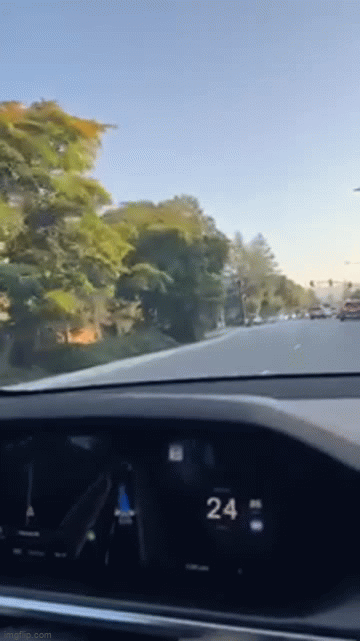Dear Reader,
On Friday, Elon Musk took a drive…
Musk live-streamed a 40-minute cruise around Palo Alto in his Tesla.
He cruised by the Stanford campus and even made a stop by Mark Zuckerberg’s home.
There wasn’t anything remarkable about the drive… Except for the fact that he didn’t touch the steering wheel. An AI was driving.
It navigated around bicycles, construction zones, and roundabouts.
It stopped at stop signs and red lights.
And it even exhibited human behaviors like switching into a lane with the fewest cars at an intersection.

Source: X.com, @elonmusk
Readers are likely familiar with Tesla’s FSD (full self-driving) feature. As the name suggests, it’s an autonomous driving feature that allows the Tesla to handle most driving situations on its own. The technology has been good – but not perfect – for a long time.
But this version is different from previous versions.
And that has huge ramifications for the future of driving.
Let me explain.
Previous versions of FSD were a combination of human-written code and AI.
A developer would write lines of code that told the car what to do when it identified a stop sign, for example. AI was used to improve the recognition of stop signs in cases where it was partially blocked by a tree.
But this version of FSD, V12, is different. There isn’t a single line of human-written code telling the car what a stop sign means… to avoid hitting pedestrians… or what to do around a construction zone.
The AI isn’t even taught English or what numbers mean.
Instead, powerful AI models were trained from the ground up using data from millions of miles driven in Teslas.
As Musk and his passenger explained during the drive, the hard part is parsing through all of this data to find the best examples of great driving.
Once that data is obtained, they feed it into the AI’s neural net, and it makes sense of the data.
It recognizes that every time there’s a red octagon, it has to stop.
During the live stream, Musk mused that most people don’t fully stop at stop signs. According to him, only 0.5% of drivers do.
That meant the team at Tesla had to artificially create this data set and feed it to the AI to comply with regulators.
Musk only had to intervene once during the drive. His Tesla attempted to accelerate at a red light when the left turn signal turned green.
He used that opportunity to explain that when they find errors like that, developers build a data set of good examples of what to do in that situation. They then train the AI on the new data to improve its performance.
The heavy lifting is done on the AI training. This is where billions are spent on hardware and curating data. But once the AI is trained, it’s capable of running on a Tesla without an internet connection.
This version of FSD is still being tested. But based on Musk’s demo, it’s only a matter of time until he rolls it out to the Tesla fleet.
I believe this version of FSD will be capable of Level 4 self-driving… one day even Level 5.
Level 4 self-driving is when the car can drive itself with minimal interference. It’s sometimes called “mind-off” because drivers are supposed to be able to sleep during their main transit.
Level 5 is when the car can drive without a steering wheel or pedals. This is considered the “holy grail” of autonomous driving.
That’s been Tesla’s goal since at least 2015.
While this is potentially great news for Tesla, it’s an even more important testament to the power of AI.
FSD V12 started from a blank slate. The AI learned how to drive just from watching humans do it. And it did it in less time than it took developers to crack the code.
That means with enough data and computing power, AI can be used to solve other complex issues. I’m most hopeful for AI’s use in improving medical diagnosis, robot dexterity, and scientific and drug research.
Musk showed us that with enough data and computing power, AI can do something as complex as driving. This is a testament to why we spend so much time focusing on artificial intelligence in these pages.
When I say that artificial intelligence will touch almost every aspect of business, the economy, and our daily lives, I mean it. We could be on the verge of never having to manually drive again. And it’s all thanks to artificial intelligence.
That’s why we spend so much time tracking these developments. And it’s why I believe AI will be the most important investing trend of the next decade.
Regards,
Colin Tedards
Editor, The Bleeding Edge
The Bleeding Edge is the only free newsletter that delivers daily insights and information from the high-tech world as well as topics and trends relevant to investments.
The Bleeding Edge is the only free newsletter that delivers daily insights and information from the high-tech world as well as topics and trends relevant to investments.